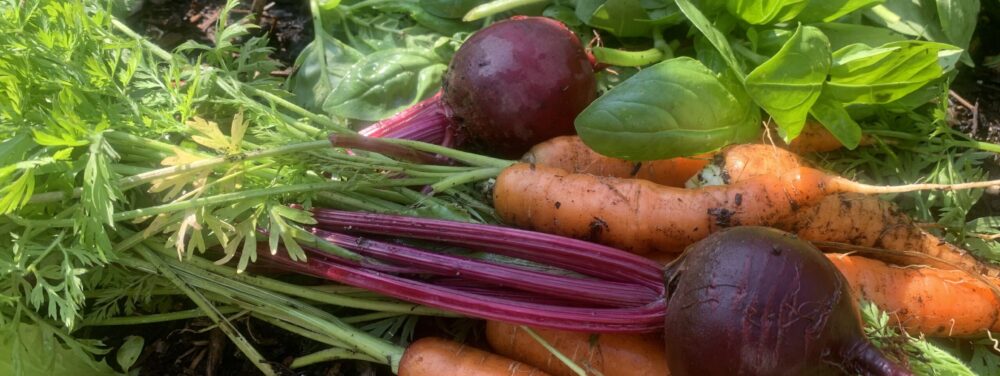Are you new to vegetable gardening? Or getting ready to create a new vegetable garden? Here are 6 things to know before starting your vegetable garden (pssst…it’s about simple planning):

Sunlight
Plant vegetables in an area that gets full sun. South, southwest, and southeastern exposures work if the sunlight isn’t blocked by trees, fences, or buildings. If you have a yard that faces south, finding your spot for your garden might be easy. But if a full sun exposure is limited, you might have to get a little creative. How can you use the full sun space that you have? If you don’t have much space, is there room for containers or grow bags? Can you grow some food vertically? Peas, beans, cucumbers, and squashes all love to grow up and vertical growing can take up less ground space.

Soil, Soil, Soil
Think of soil as food for your plants. The topic of soil is complex. But the good news is most vegetables aren’t picky about soil as long as the plants have enough moisture, nutrients, and organic matter. As you grow more plants, consider learning more about soil. To start, keep it simple:
Your soil should retain some moisture but also drain well. You want your soil to be moist enough so your plants’ roots can take up the nutrients from the soil. But you don’t want your soil so wet that it rots your plants’ roots.
The 3 main nutrients that plants need from soil are nitrogen (N), phosphorus (P), and potassium (K). These nutrients are often shown as ratios. Some call it the N-P-K factor. If you look at soil or fertilizer bags at your local garden store, you might notice something like 10-10-10. This ratio indicates a balanced fertilizer, meaning that soil or fertilizer has an equal amount of nitrogen, phosphorus, and potassium (about 10 percent of each).

Consider adding nutrient-rich soil to your existing soil. Visit your local garden store and ask what soil they suggest for your garden. You can likely purchase soil in bags. Or, if you have a local landscaping company, ask if they sell quality compost or soil for garden beds. If you have a budget big enough, they just might deliver a truck load. If you have money to spend on your vegetable garden, consider spending most of it on your soil, especially if it’s a new garden. Remember, your soil is what feeds your plants.
As time goes on, add organic matter to your soil . Your plants will use the soil’s nutrients and so, your soil will need to be replenished. Regularly adding organic matter to your garden beds will boost your soil’s health. I add aged chicken manure and compost to my vegetable beds about every 6 weeks during the growing season. For a free or inexpensive way to replenish your soil’s nutrients, learn to create your own compost.
Water Supply
Consider the location of your water source. Do you have a hose tap nearby? Or do you have to use an inside tap to fill a watering can? When your water source is convenient to access, you’re more likely to water your garden, when needed. And the less time it takes you to water your garden, the more time you have to just sit and relax in your garden.

Quality Seeds
Buy high quality seed. Buy high quality seed. One more time: buy quality seed.
If you can, buy seed from local gardeners and farms. Seed that grows locally is adapted to the growing conditions in your region. I purchase seeds from B.C. Eco Seed Co-op, an organization that sells certified organic seeds that have been collected from farms in my region (southwest coast of British Columbia).
Pay attention to the date on seed packages. I don’t pay for seeds that are more than 1 year old. The older the seed, the less chance of those seeds germinating.

Store your seeds in a cool, dark, dry area.
If your seeds aren’t germinating, they might be too old. Consider buying new seeds or trade seeds with another gardener in your area.
Or, the conditions might not be right for the seeds to germinate. Read the information on your seed packets and check out the How To section of this blog to learn what your seeds need to germinate.
Timing
Before starting your vegetable garden, know when to plant your vegetables.
Read the instructions on your seed packages to learn when to plant your vegetables. Or read the How To posts in this blog.
Some plants like peas, lettuce, kale, broccoli and spinach like cooler temperatures. Those plants should be planted outdoors in early or mid spring. For cool-weather-loving vegetables you can start growing in early spring, read 5 Vegetables You Should Plant In March.
Other plants like tomatoes, peppers, cucumbers, and squash like warm and even hot temperatures. Plant the hot-weather vegetables in late spring or early summer.

Companion Plants And Enemy Plants
Just like people do better around certain people, some plants do better around certain plants. And some plants even struggle when they are near certain plants (hmmm…not every human is easy to be around either).
Luckily, many vegetables thrive with the company of other vegetables.
If you want to help your vegetables thrive, or know which vegetables to not plant together, learn about companion planting. And then give it a whirl!
These are some things to know before starting your vegetable garden. Pay close attention to your sunlight, soil, and water. Buy high quality, local seed. And know when and where to plant your seeds. This little bit of simple planning is worth the effort before starting your vegetable garden.


